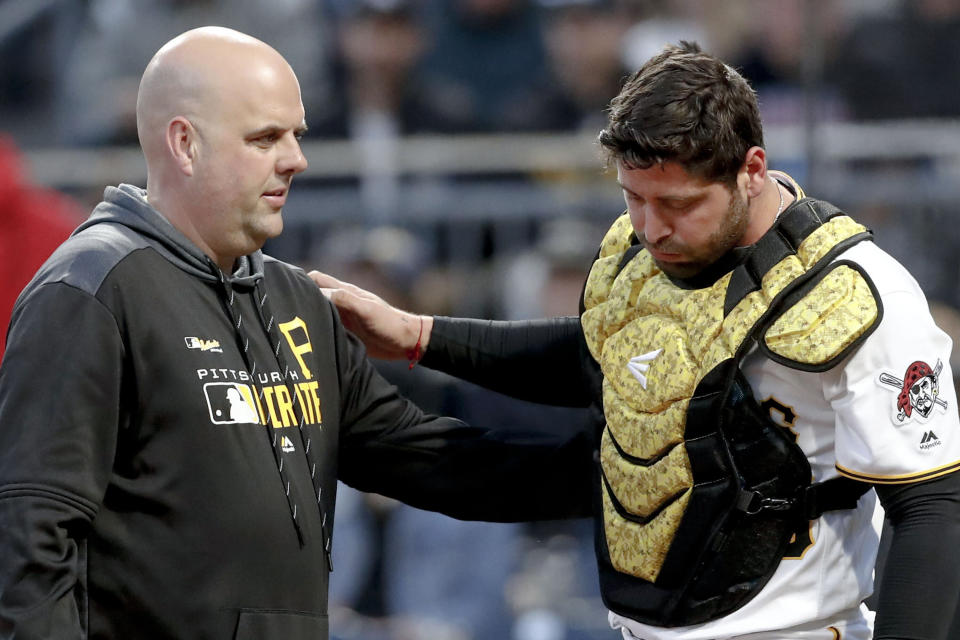Pirates GM wants rule change to take pressure off possibly concussed catchers

In an era where concussion concerns are taken more seriously than ever before, one general manager feels Major League Baseball is again falling behind.
Pittsburgh Pirates GM Neal Huntington gave his unprompted take and ensuing rule proposal to the media Sunday in the wake of catcher Francisco Cervelli’s seventh trip to the concussion IL since 2015.
Huntington sees the current rule, particularly in regard to catchers, as a lose-lose situation: stay in the game and potentially worsen a brain injury, or leave out of precaution only to find out there’s no issue and put the team’s chances in jeopardy.
“It used to be, you’d get your bell rung and you’d stay in,” Huntington said, per The Athletic. “We shouldn’t do that anymore. We should understand what that actually means. Our players’ safety should be first and foremost.”
Pirates GM: pressure is too much without rule
Huntington’s issue is based around the substitution rule and its impact on players. Players can’t return to the game after being removed; he’d like to see a rule change that allows players potentially concussed to return if they clear a full concussion test by a medical professional.
From the Pittsburgh Post-Gazette:
"The player has to feel pressure, as he’s standing there with 10,000 or 30,000 or 50,000 eyes on him, to make a decision, ‘Am I in or out of this game?’ " Huntington said. "He knows if he takes himself out and he’s the catcher, there’s only one other catcher, and the game becomes a fiasco if that other catcher gets hurt."
Huntington told media he wants an “obvious concussion assessment process to happen.”
The initial decision is easier on position players, who have multiple players available to take their spot. For catchers, who are most liable to take a 90 mph fastball to the head, it’s far more difficult. And concussion symptoms don’t always present themselves immediately, as was the case for Cervelli on Saturday.
Cervelli was hit by a broken bat in the fourth inning and stayed in the game after an athletic trainer checked on him. In the bottom of the inning he came out to the on-deck circle, but shortly afterward went back to the dugout and was out of the rest of the game. Less than 12 hours later, he was placed on the seven-day concussion injured list.
Huntington: It ‘changes tradition’
As with any potential rule change in MLB, Huntington knows it will rile up some of the game’s traditionalists and that’s likely to be the biggest hurdle.
“We’re going to abuse it — not necessarily we (the Pirates), but as an industry, teams will abuse it. And it changes tradition. I probably should’ve had some behind-the-scenes conversations before having a public one today, but now it’s out there so, hopefully, there will be a dialogue.”
Even if it doesn’t happen often, Huntington said that’s all the more reason to put a substitution stipulation in place. A 2018 study on post-concussion performance showed an increase in reported concussions after the 7-day DL (now IL) was implemented to better maintain them. Catchers were the most likely to sustain concussions, per the study.
Every spring rule changes are proposed and debated, though few are implemented over the years. This would be less about how the game is played and more about keeping players as safe as possible.
NFL’s approach to concussions
The crux of the concussion conversation focuses on the NFL. The league implemented its first “concussion protocol” in 2009 and has adjusted it since to keep players safe. When a potential concussion is identified, the player is removed from the field and looked at by a medical professional in the locker room. There are also independent medical spotters at games.
If a player is cleared, he may return to the game. Baseball is the only sport that doesn’t allow players to re-enter a game, making it more of a challenge for concussion assessments.
All leagues struggle with how to handle an injury that doesn’t present itself in the same way a broken leg would. Soccer is under fire for its handling — or lack thereof — of concussions after a player was medically cleared to return, and did so with his head wrapped, but later collapsed on the field. A catcher who sustained a concussion, but stayed in the game, would face dire consequences if that same thing were to happen during game play.
More from Yahoo Sports:


